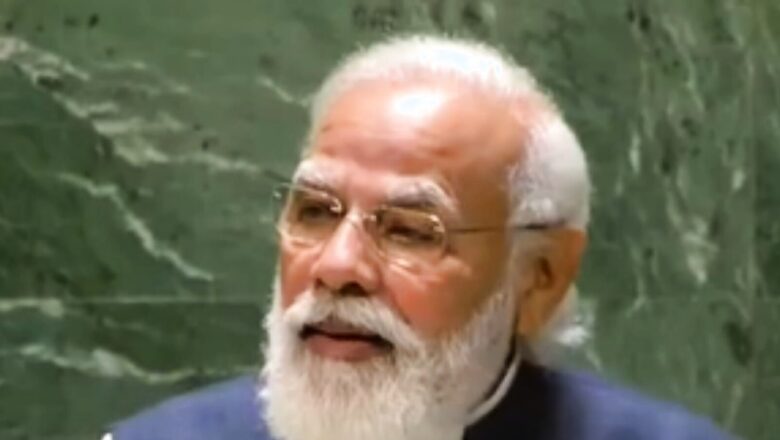
views
The 49 terrorists who were in convicted in the 2008 Ahmedabad blast case, 38 of whom have been handed the death sentence on February 19 by a special court, shows that the Narendra Modi-led government is committed to fighting terrorism. Even when Modi was the chief minister of Gujarat, he was widely praised for handling the situation in the wake of the 2002 Akshardham terror attack in which 30 people were killed.
The year 2008 saw a series of blasts rocking the country, especially in the hinterland of Delhi, Jaipur, Bengaluru and Malegaon. According to sources, the Modi government in Gujarat, at that time, realised that the nationwide terrorist networks need to be destroyed instead of focusing on just one act.
For example, when Modi was the CM, the Gujarat government displayed immense willpower to investigate the Ahmedabad terrorist attacks that had links with other states but governments in some of them were hostile to Gujarat’s attempt to bring perpetrators to justice.
According to sources, the Gujarat Police faced resistance in bringing the blast mastermind to Gujarat from Uttar Pradesh’s Azamgarh, which was under chief minister Mayawati at that time.
UP Hotbed for Terror Activities Under SP-BSP Rule
Varanasi fell victim to multiple terror attacks between 2005 and 2007, which claimed 50 lives. Under the Samajwadi Party and Bahujan Samaj Party’s rule alternatively, Uttar Pradesh was at the mercy of terrorists in 2003-2013.
Political patronage and vote bank politics made UP hotspot of terror activities under Indian Mujahideen (IM), Students’ Islamic Movement of India (SIMI) and Pakistan’s intelligence ISI.
According to a report by The Indian Express, then UP government ordered withdrawal of criminal charges against a Harakat-ul Jihad Islami (HuJi) operative accused of planting a bomb at a public place in Varanasi in 2006. “The bomb, which did not explode, was found soon after the twin blasts at Sankatmochan Mandir and Varanasi Cantt Railway Station in which 21 persons died on March 7,2006.”
The then UP government sought to withdraw charges against terror accused in Varanasi, Gorakhpur and Lucknow blasts.
Impact of CM Modi’s Work Against Terror
Modi as the CM broke the Indian Mujahideen and SIMI terror network not just in Gujarat but the entire country. The work on the Ahmedabad blasts by the Gujarat government gave leads and tip-offs in several other investigations being carried out into the terror attacks by IM in 2008. According to a Times of India article, the Gujarat Police leads helped in tracing terrorists in Batla House in New Delhi and the decimation of IM.
The sources said the Gujarat administration also set up a diligent case that led to multiple convictions in Ahmedabad blast case.
A Holistic Fight Against Terror
When Modi became the Prime Minister in 2014, he inherited India that felt like it was under siege. Ayodhya, Delhi, Varanasi, Bengaluru, Mumbai, Hyderabad and Jaipur were major cities which were the targets of terrorists between 2004 and 2014. Hundreds of civilians were killed every year.
According to South Asia Terrorism Portal, there was a stark reduction in terrorists attacks that happened outside of Jammu and Kashmir, Punjab and Northeast after 2014.
PM Modi’s strategy against terrorism involved international diplomacy, giving free hand to the armed forces, calling out nuclear bluff of Pakistan and bringing terror as a topic of discussion at the high table of G20.
He gave more teeth to existing laws such as the NIA (Amendment) Act 2019 and Unlawful Activities (Prevention) Amendment Act 2019 to empower the intelligence agencies investigating terror activities abroad as well. This was complemented by the Abrogation of Article 370 in Jammu and Kashmir in August 2019 and streamlining of Border Security Force to make it more effective.
Armed forces have often publicly expressed not receiving political backing, which was changed under PM Modi as Indian Army’s operations in Myanmar, crossing LoC in Pakistan to avenge the 2016 Uri attacks and Balakot air strike to call out the nuclear bluff of Pakistan.
In fact, according to the home ministry, incident of Left-Wing Extremism (LWE) reduced by 70% from all-time high of 2,258 in 2009 to 665 in 2020. In Jammu and Kashmir, 849 incidents of terror were reported between April 2017 and August 2019, and the activities nearly halved between August 2019 and November 2021 to 496. Northeast also witnessed unprecedented transformation with 824 incidents of violence reported in 2014, which slumped to 162 in 2020. There has been 80% drop in insurgency incidents between 2014 and 2020.
The Modi government achieved this by fencing LoC and border along all neighbours. In December 2014, 734 km of fencing was done along Pakistan border and LoC as compared to additional 1,306 km already constructed by December 2020.
Agencies such as the National Investigation Agency have been strengthened across the country. The budget for modernization of police forces focusing on modern technology, forensics was Rs 26, 275 crore alone in 2021-22.
The government is also actively hitting the finances of terror organisations. The government froze assets of Dawood Ibrahim. There has been an additional crackdown on narcotics and drugs.
Raising the Pitch on Terror Globally
PM Modi was the first who threw the light on there is no good and bad terror. In his maiden speech at the United Nations General Assembly in 2014, reminded the world of the obligation to remove all kinds of terror.
At the Shanghai Cooperation Organization (SCO) last year, PM Modi stressed the developments in Afghanistan after the US troops withdrawal and resurgence of Taliban.
The BRICS (Brazil, Russia, India, China and South Africa) summit adopted the counter-terrorism action plan under the leadership of PM Modi in 2021.
Read all the Latest News India and Breaking News here

















Comments
0 comment